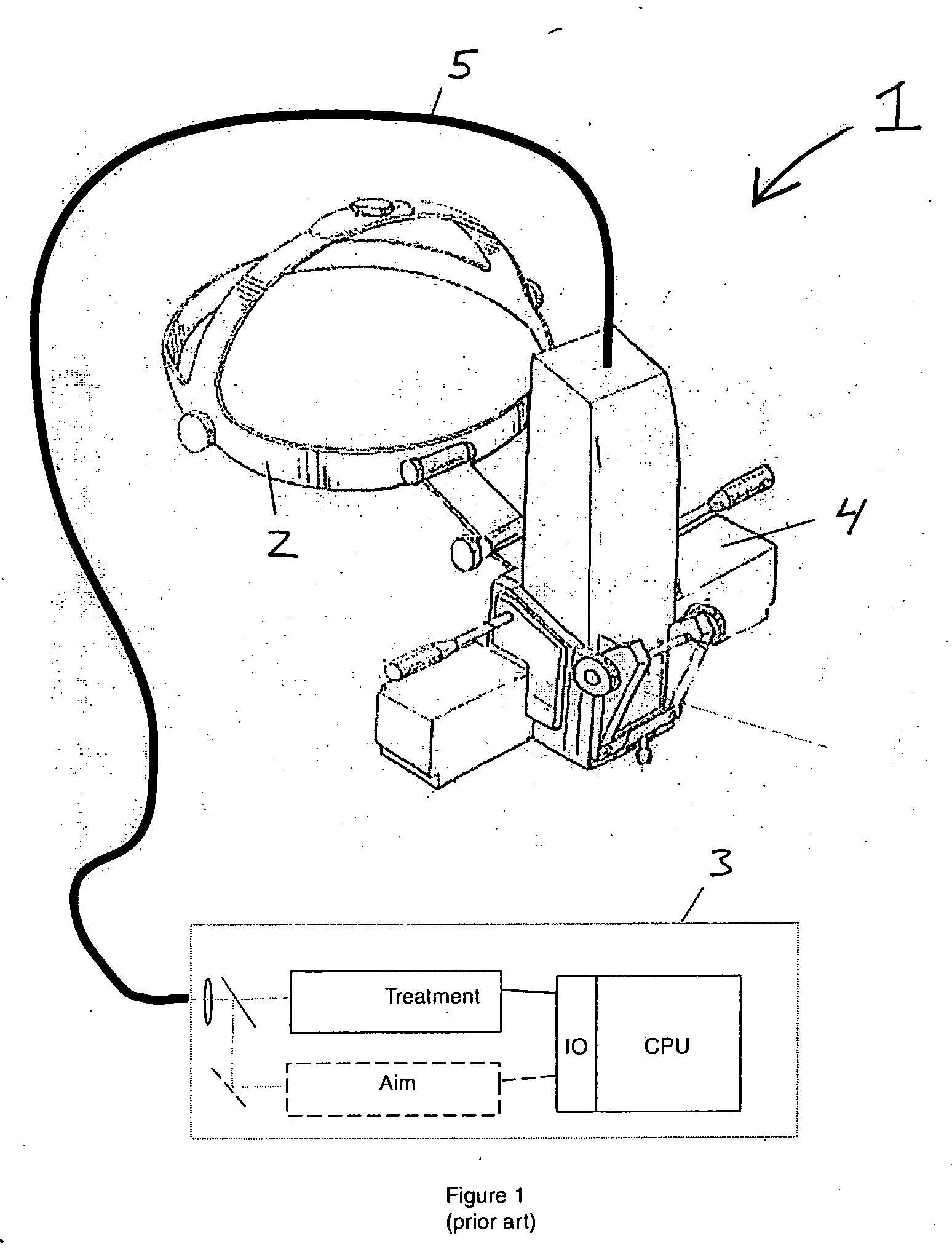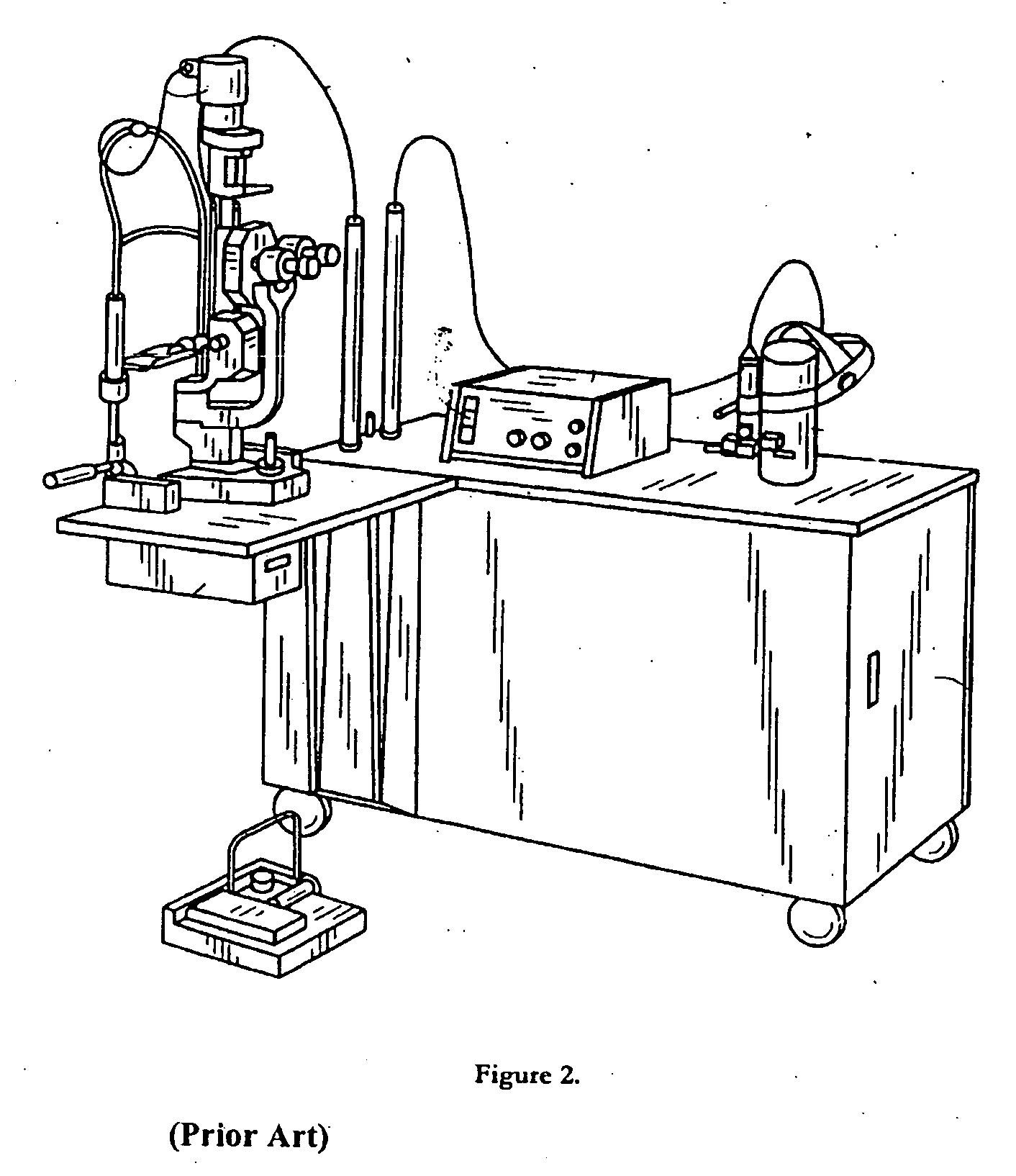Multiple spot photomedical treatment using a laser indirect ophthalmoscope
a laser indirect ophthalmoscope and multi-spot technology, applied in the field of retinal tissue patterned photothermal treatment, can solve the problems of damage to the patient's sensory retina, irreversible damage to the overlying sensory retina, and s
- Summary
- Abstract
- Description
- Claims
- Application Information
AI Technical Summary
Problems solved by technology
Method used
Image
Examples
first embodiment
[0026]FIG. 3 is a schematic diagram of a photomedical system 100 in accordance with the invention. The photomedical system 100, which may be used for photomedical treatment or diagnosis, includes a CPU 12, an electronic input / output device 14, a light generation unit 15, and an LIO apparatus 16. The light generation unit 15 is optically coupled to the LIO apparatus 16 by a fiber unit 42. A user, such as a physician, wears the LIO apparatus 16 to view a target with his / her eye 34 through an ophthalmic lens 19. In this case, the target is the retina of an eye 1 (i.e., the patient's eye). The user 34 may see the eye 1 directly or through a screen, such as graphical user interface 36. The CPU 12 is coupled to the light generation unit 15 to control light generation. Optionally, the CPU 12 also controls the LIO apparatus 16. The CPU 12 may be a microprocessor, microcontroller, or any other type of suitable control electronics.
[0027] The light generation unit 15 includes a light source 10...
second embodiment
[0042]FIG. 6 is a schematic diagram of the beam multiplier BM. In this embodiment, the beam multiplier BM includes an optical element with focusing power, specifically an off-axis moving lens 68 that is movable transversely to the optical axis and able to rotate eccentrically (i.e. not about its optical axis). As the lens 68 spins, the optical beam 11 coming from the lens L2 reaches different parts of the lens 68, thus getting refracted differently depending on what portion of the lens 68 is encountered. The lens L4 directs the optical beam 11 coming from different angles emanating from lens 68 to different spots on the mirror M4. The lens 68 may be replaced with a mirror in other embodiments, where different portions of the moving lens 68 would reflect the beam at different angles.
third embodiment
[0043]FIG. 7 is a schematic diagram of the beam multiplier BM. In this embodiment, the beam multiplier BM includes a rotating reflective polygon scanner 70 and a reflective element 72. The rotating polygon 70 may be configured to provide different deviation angles on different facets. As the polygon rotates about an axis 71, the optical beam 11 coming from the lens L2 hits different points on the polygon 70 and leaves the polygon 70 at different angles. The reflective element 72 receives the optical beam 11 from the polygon 70 and directs it to the lens L4. The lens L4 forwards the optical beam 11 to the mirror M4. The position on the mirror M4 that the optical beam 11 strikes differs depending on which part of the polygon 70 reflects the optical beam 11.
[0044]FIGS. 8 and 9 are schematic diagrams of fourth and fifth embodiments of the beam multiplier BM, respectively. The fourth and fifth embodiments utilize diffraction elements. In FIG. 8, the beam multiplier BM includes a transmis...
PUM
 Login to View More
Login to View More Abstract
Description
Claims
Application Information
 Login to View More
Login to View More - R&D
- Intellectual Property
- Life Sciences
- Materials
- Tech Scout
- Unparalleled Data Quality
- Higher Quality Content
- 60% Fewer Hallucinations
Browse by: Latest US Patents, China's latest patents, Technical Efficacy Thesaurus, Application Domain, Technology Topic, Popular Technical Reports.
© 2025 PatSnap. All rights reserved.Legal|Privacy policy|Modern Slavery Act Transparency Statement|Sitemap|About US| Contact US: help@patsnap.com



